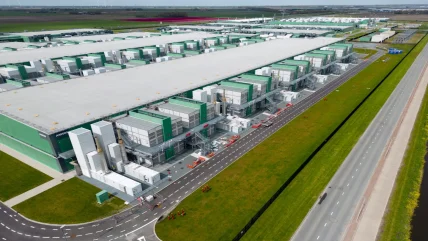
The European data centre market is set for significant expansion in 2025, according to new research by CBRE Group. In its latest report, the real estate services firm projects 937MW of new capacity, marking a 20% increase from the previous year. This follows a total of 655MW of new supply added in 2024, up from 561MW in 2023. This expansion is driven by growing demand from hyperscale cloud providers, stricter data localisation policies, and increased reliance on colocation services.
CBRE’s latest findings highlight supply constraints in Frankfurt, London, Amsterdam, Paris, and Dublin (FLAPD), prompting operators to invest in alternative locations. Secondary markets are seeing increased development as companies look for new capacity beyond the primary hubs. The shift follows a pattern of sustained demand exceeding supply, with availability continuing to decline.
Of the 937MW of new supply forecast for 2025, 677MW is expected to be concentrated in FLAPD markets. With land and power availability becoming a challenge, data centre operators are looking to secondary markets for expansion. CBRE projects that five of the ten tracked secondary markets will experience double-digit growth in supply. Seven secondary markets, including Milan and Madrid, are expected to exceed 100MW of total supply by the end of 2025, up from four in 2022. In 2024, a total of 297MW of new supply was delivered in Q4 alone. Among the primary markets, Dublin added 62MW, Frankfurt 56MW, and Paris 34MW. Secondary markets accounted for 145MW of new capacity in the quarter, with Oslo and Berlin seeing the highest increases.
“Given the lack of availability in primary markets, some organisations are turning to data centres in smaller, secondary markets to meet requirements,” CBRE stated.
Data centre vacancy rates declining
Colocation take-up across Europe reached 341MW in Q4 2024, surpassing the 297MW of newly added supply. Full-year take-up totalled 706MW, marking a record for the seventh consecutive year. The demand has been largely driven by the expansion of hyperscale cloud regions, with AI-specific infrastructure needs also contributing to growth. A lack of available AI-compatible facilities in FLAPD markets may lead to more activity in secondary locations. Pre-leased agreements played a significant role in 2024, accounting for 66% of total take-up across Europe. In FLAPD markets, 63% of take-up resulted from prior-year signings, while in secondary markets, pre-leased deals represented 71% of total take-up.
Vacancy rates across Europe declined further, reaching 10% in Q4 2024, a new low. FLAPD markets saw an 8% vacancy rate, down by 1.5 percentage points from the previous quarter. Demand in these markets continued to exceed new supply, with 444MW of take-up in FLAPD markets compared to 375MW of new supply in 2024. This trend has continued for three consecutive years, reinforcing the supply constraints in major hubs. By the end of 2025, CBRE expects the overall European vacancy rate to decline further to 8.5%, marking the first time it falls below 10%. Limited land and power availability are expected to drive companies to consider alternative locations and existing data centre space to secure capacity.
Frankfurt recorded the highest annual take-up among European data centre hubs at 140MW in 2024, maintaining the lowest vacancy rate in the region. London’s annual take-up reached 116MW, surpassing new supply for the third year in a row, with hyperscaler leasing activity focused on the western corridor. Amsterdam recorded 10MW of take-up, reflecting limited new supply. Paris saw record-high take-up, supported by the launch of a new hyperscaler-focused data centre in its southern region. Dublin’s take-up totalled 64MW, outpacing new supply, though power constraints remain a challenge for future developments.
Secondary markets accounted for 262MW of total take-up in 2024, with Berlin, Madrid, Milan, Oslo, and Warsaw representing nearly 90% of that total. Increasing demand in these regions reflects ongoing challenges in securing power and land in primary hubs.






